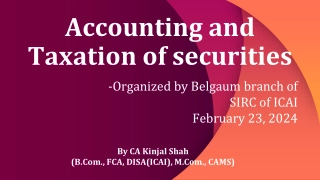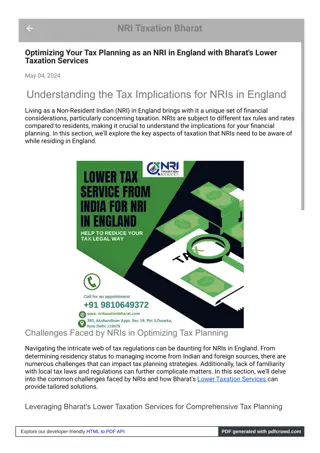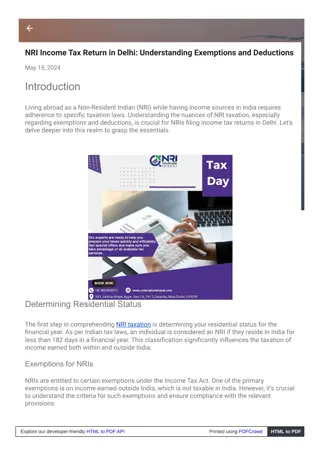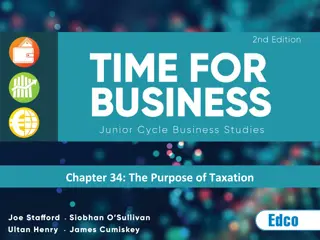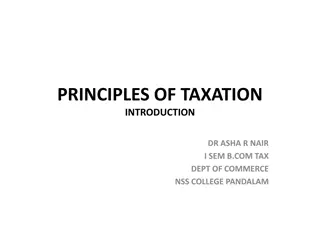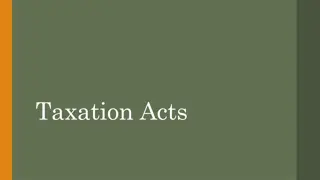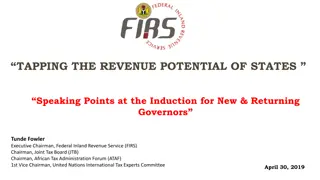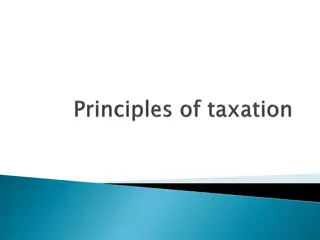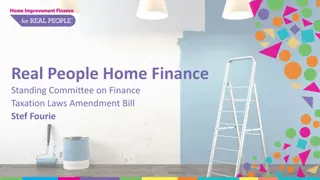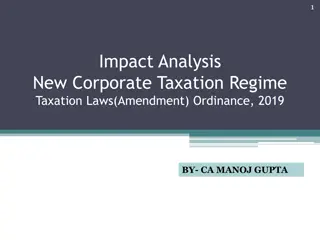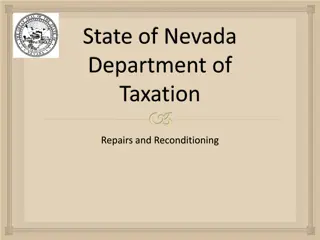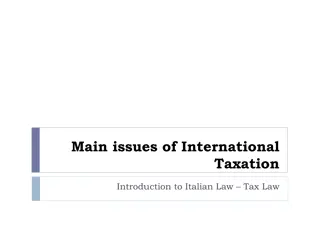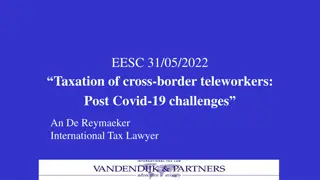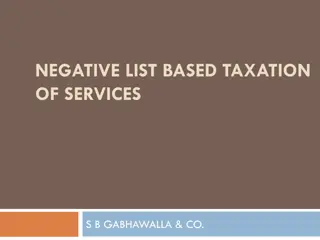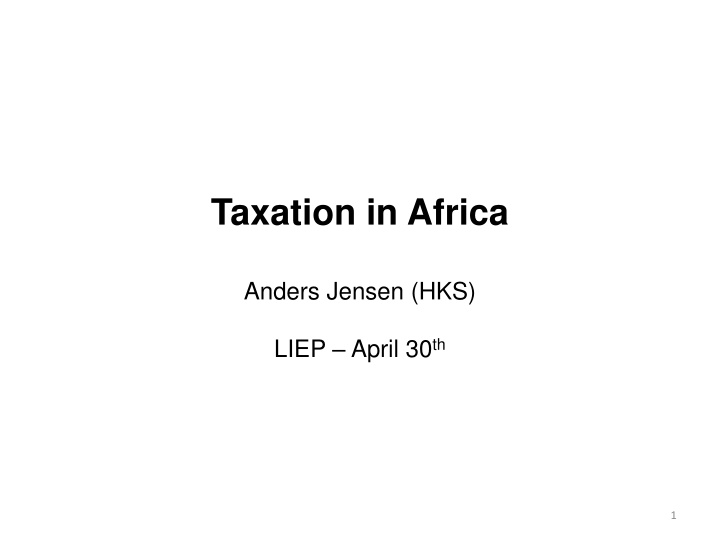
Taxation Insights in Africa
Delve into diverse projects focused on taxation in Africa, including new findings across space and time, the impact of taxation on labor and capital, and more. Explore detailed data sets covering 100 countries over 60 years to understand the nuances of tax revenue sources and effective tax rates. Gain valuable insights for shaping future tax policies and economic strategies in the region.
Download Presentation

Please find below an Image/Link to download the presentation.
The content on the website is provided AS IS for your information and personal use only. It may not be sold, licensed, or shared on other websites without obtaining consent from the author. If you encounter any issues during the download, it is possible that the publisher has removed the file from their server.
You are allowed to download the files provided on this website for personal or commercial use, subject to the condition that they are used lawfully. All files are the property of their respective owners.
The content on the website is provided AS IS for your information and personal use only. It may not be sold, licensed, or shared on other websites without obtaining consent from the author.
E N D
Presentation Transcript
Taxation in Africa Anders Jensen (HKS) LIEP April 30th 1
ROADMAP Present different projects related to taxation in Africa All of them (very much) work in progress: appreciate all comments and feedback! 2
ROADMAP 1. Taxation in the long-run: new facts across space and time 2. Taxation and technology: evidence from Ghana 3
ROADMAP 1. Taxation in the long-run: new facts across space and time 2. Taxation and technology: evidence from Ghana 4
I NEW FACTS ACROSS SPACE AND TIME Joint work with Pierre Bachas (WB) and Gabriel Zucman (UC Berkeley) Construct panel data-set covering 100 countries over 60 years between 1955 and 2015 Detailed information on sources of tax revenue and social security contributions Detailed information on national accounts Span and granularity allows us to overcome limitations of current (tax revenue) databases Limited time-series in developing countries: meaningfully begins early/mid 1990s Limited disaggregation of sources : per example, PIT versus CIT under Income Non-existent distinction between national and sub-national Exclusion of important sources: social security, direct taxes on capital 5
I EFFECTIVE TAX RATES ON CAPITAL VERSUS LABOR First research question: Long-run trends in the effective tax burdens on capital, labor, and consumption Conceptual motivation: Distribution of tax burden among national income components and the determinants of that allocation are important Inform impact of (aggregate) taxation on major macroeconomic variables, including investment and employment Changes in relative burdens over time affect income inequality across households Guide tax policy design: association with changes in underlying factor shares Empirical motivation: Statutory (marginal) rates can bear little relation to actual taxes paid In many macro models, effective (average) tax burden is conceptually correct metric Relate realized tax revenues directly to macroeconomic variable: Lucas (1991), Mendoza (1994) Construct average effective tax rate of labor, capital, and consumption in the National Accounts Follow OECD methodology (2015) Adjust to developing country context: Micro-data in selected developing countries to help assess magnitude of potential bias derived from aggregate data 6
I EFFECTIVE TAX RATES ON CAPITAL VERSUS LABOR Least developed countries High developed countries .35 Macro tax rate :=[Tax revenue_acty/GNP_acty] .25 Macro tax rate :=[Tax revenue_acty/GNP_acty] .3 .2 .25 .15 .2 .15 .1 .1 .05 .05 0 0 1999 2001 2003 2005 2007 2009 2011 1999 2001 2003 2005 2007 2009 2011 Year Year Labour Capital Labour Capital 7
I TAX ACCELERATIONS Second research question: Tax accelerations in developing countries Stylized facts based on cross-country and within-developed countries over time at odds with SSA within-country over time Large heterogeneity across SSA countries (South Africa, Kenya, Tanzania, Ethiopia) Set of policy-revenant Qs 1. How likely are developing countries to undergo sustained acceleration of tax collection? Which revenue bases, if any, are most likely to see sustained accelerations? 2. What factors are associated with such transitions? Analysis requires long-time series, while important potential factors predate pre- existing databases Changes to structure of government (e.g. independence) Openness (e.g. WTO membership) Tax reforms (e.g. VAT introduction) Economic reforms and crises Growth-analogue: Hausman, Pritchett, and Rodrik (2005) 8
I NEW FACTS IN SELECTED SSA COUNTRIES Stylized fact : long-run positive growth in tax collection (relative to GDP) Holds in South Africa Instead: acceleration followed by long stagnation Kenya Instead: acceleration(s) followed by erosion, lead to current non-recovery Tanzania, Ethiopia Stylized fact : gradual shift in composition away from traditional taxes (trade) towards modern taxes (income) Holds in South Africa Instead: prevalence of modern taxes even in early periods Kenya Instead: no long shift from traditional to modern Tanzania, Ethiopia 9
I KENYA: 1960-2010 WTO Indep VAT IMF .2 .15 .1 .05 0 1960 1970 1980 1990 2000 2010 year Trade Consumption Income Total 10
I SOUTH AFRICA: 1960-2010 IMF WTO VAT .3 .25 .2 .15 .1 .05 0 1960 1970 1980 1990 2000 2010 Year Trade Consumption Income Total 11
I TANZANIA: 1960-2010 Indep IMF VAT WTO .2 .15 .1 .05 0 1960 1970 1980 1990 2000 2010 year Trade Consumption Income Total 12
I ETHIOPIA: 1960-2010 VAT IMF .25 .2 .15 .1 .05 0 1960 1970 1980 1990 2000 2010 year Consumption_Trade Income Total 13
ROADMAP 1. Taxation in the long-run: new facts across space and time 2. Taxation and technology: evidence from Ghana 14
III TAXATION AND TECHNOLOGY Joint work with James Dzansi, Henry Telli (University of Ghana, East Legon), and David Lagakos (UC San Diego) Joint policy-research collaboration with Ministry of Finance and Ministry of Local Government in Ghana 15
III TAXATION AND TECHNOLOGY Limited observability is key constraint to tax collection in developing countries Wedge between (well intended) statutory policies and effectively implemented policies Increase in discretionary power of intermediaries (e.g. local tax collectors in the field) Costly and inefficient collection process State investments in technology can potentially alleviate observability constraints Recent theoretical work (Besley and Persson, 2009, 2010) Limited empirical evidence on returns to investments in tax capacity Investment is associated with large impacts (case-studies) But decision to invest, and implementation conditional on investing, may be driven by underlying revenue trends and/or correlated with determinants of revenue collection Well-identified evidence from other technology investments in state capacity find high returns, including Delivery of anti-poverty programs in India: Muralidharan [2016] Voting technology in Brazil: Fujiwara [2015] Electronic procurement in India and Indonesia: Lewis-Faupel, Olken, Neggers, Pande [2016] 16
III TAXATION AND TECHNOLOGY IN GHANAS LOCAL GOVERNMENT In this project, we present evidence from a large-scale experimental evaluation of the technology on property taxes in Ghana Randomize roll-out across 98 districts, covering 18 million people Randomization at full organizational scale of local governments Project is part of on-going collaboration with central and local government agencies to improve local tax collection performance Consensus (supported by data) that exists strong potential for improvement Iterative process: (long) list of potential determinants, uncertain returns to each Context: low adoption of tax-enhancing technologies Pre-existing technology developed around 2013 in collaboration with foreign aid agency, proposed by Ministry of Local Government Reasons for non-adoption (baseline survey) Did not know about technology Technology inadequate for district-specific setting 17
III REASONS TO BE OPTIMISTIC Limited observability is ubiquitous feature of property taxation in SSA Improved IT systems often hailed as a potentially transformative tool (APTI, 2017) IT reforms under way in Ethiopia, Nigeria, Senegal, Sierra Leone Recently developed technology by Ghanaian private firm GIS-based system dramatically lowers cost of building and maintaining property registry Locally appropriate billing, payment, and enforcement software using GIS-system as automated data input Real-time monitoring of tax collectors, and (third-party) customer service Baseline survey suggests that this locally developed technology could plausibly improve local tax collection 15% of districts have any form of technology But adoption of technology is associated with 50% increase in revenue Cost of collection is 49% (lower bound) Compared to 0.45% in US (IRS, 2010) 35% of properties receive official tax bill, with a recovery rate of 63% High recovery rates consistent with Pakistani setting: Khan, Khwaja, Olken [2015] 18
III REASONS TO BE SKEPTICAL Implementation requires solving a complex mix of technical and logistical challenges (Andrews, Pritchett, Woolcock, 2017) Undertaking may fail unless all components are well-implemented (Kremer, 1993) Vested interests whose rents are threatened may subvert the intervention and limit its effectiveness Individual tax collectors and/or central administrators Dampen incentives to collect taxes in first place, and thus reduce levels of local public goods Even if aggregate revenue collection impact is positive, uncertainty about Overall cost-effectiveness (actual and as perceived by local decision-makers) Distributional consequences 19
III RESEARCH DESIGN Limited evidence to support either enthusiasts or skeptics of investments in technology to alleviate tax observability and collection constraints Aim to fill this gap in a large-scale experimental evaluation of newly developed technology for local governments in Ghana Randomize the order in which 98 local governments are offered technology by private firm Up to date, GIS-based property registry Locally tailored revenue software for billing, payment, enforcement, using GIS input Evaluation 50 treatment districts, 48 control districts 18-24 months evaluation period Intervention design Conference event : overcome information barrier Follow-up showcase events in treated districts: involve large number of authorities 20
III BALANCE Control 12.661 Treatment -0.241 (0.366) P-value 0.511 Log total IGF Log IGF per capita 1.183 0.047 (0.140) 0.733 Recovery rate [Percent, 0 to 100] 63.329 -4.679 (4.836) 0.336 Exist Database and/or Software Technology? [Dummy, 0 or 1] 0.216 -0.012 (0.099) 0.896 Cost of collection [Percent, salary of revenue collected] 0.491 -0.030 (0.061) 0.627 Urbanization rate [Percent, 0 to 100] 46.477 -3.598 (3.392) 0.362 Ever worked with Land Valuation Board? [Dummy, 0 or 1] 0.437 0.030 (0.089) 0.740 Joint significance [Chi square test statistic] 6.31 0.504 21
III DIMENSIONS OF ANALYSIS ??? ?????????? = ????? ???????? ??????? ???????? ???? Net tax revenue performance H1: Intervention increases coverage rate and recovery rate Data: monthly administrative data and end-line survey H2: Intervention reduces cost of collection (at least head-quarter resources) Data: yearly administrative data and end-line survey Given baseline values, suppose 25% improvement in coverage rate, recovery rate, cost Would lead to 98% increase in nettax revenue collected Leakage (imperfect proxies) H4: Intervention reduces head-quarter leakage ( double books ) H5: Intervention reduces in the field leakage (reduced collector bargaining power?) Data: yearly Auditor General data and combined end-line with administrative data Tax revenue production function Technology and labor complements vs substitutes in the revenue production function? H6: Intervention leads to change in number of field collectors Data: yearly administrative data and end-line survey 22
III DIMENSIONS OF ANALYSIS Household preferences H6: perceived state capacity improvement leads to higher reported satisfaction and engagement with local government H7: increased accountability from capacity-driven additional funding Stronger alignment of expenditure with citizens listed preference over expenditures Data: end-line survey Leadership preferences (legislative, executive, bureaucratic) H8: change in time-horizon and aversion to tax Data: end-line survey 23
III RESEARCH DESIGN: UPSIDE To date, no experimental evaluation of investment in tax capacity Internal validity (+) Evaluate implementation by local government at full-scale And, heterogeneity in pre-existing administrative capacity and economic structure External validity (+) Constraints tackled by our specific technology are ubiquitous across SSA Policy-relevance (+) 24
III RESEARCH DESIGN: DOWNSIDE Will not be able to experimentally investigate barriers to adoption of technology Non-adoption at baseline and imperfect take-up of proposed technology Provide suggestive evidence based on rich heterogeneity analysis Intervention is bundle of sub-interventions Plausible that all sub-components are required for successful implementation Can only provide non-experimental decomposition of treatment effects (Muralidharan et al., 2016) 25
III TIMELINE Intervention in May 2018 We are planning for failure Monitor take-up Elicit feedback in first months of engagement with TG districts At the moment, end-line aimed for January 2019 26
Thank you for your comments! anders_jensen@hks.Harvard.edu Rubenstein 328 27


